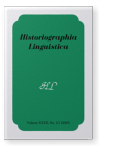Vol. 32:1/2 (2005) ► pp.1–33
The definitions of the Greek Middle Voice between Apollonius Dyscolus and Constantinus Lascaris
The present study offers a typological and a chronological classification of all the extant definitions of the middle voice from Apollonius Dyscolus (2nd century A. D.) to Constantinus Lascaris (1434–1501), the last significant Byzantine grammarian of the Modern times. As a result of the investigation, it becomes clear that there was no generally acknowledged definition of the middle voice in the Greek grammatical tradition until the Renaissance, when the last Byzantine grammarians attempted an all-embracing and complex systematization of the verbal voices. Before that time, what we find is a range of five different definitions, which were combined in different ways by Greek grammarians according to their needs and the scope of their works. Accordingly, the Greek Canones (morphological tables which listed and commented all variant forms of the corresponding verbal conjugations) generally stressed the morphological differences of the middle forms, whereas the Syntaxes neglected morphology and centred on the semantics and syntactic constructions of the middle verbal paradigms. The combination of both criteria in the more general and theoretical Grammars would thus allow for a variety of interpretations.
